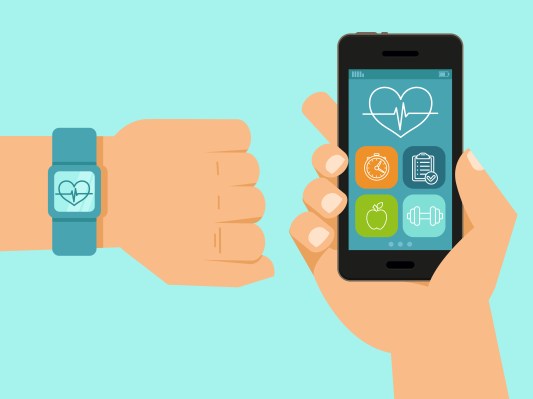People are checking their phones more than ever. The average person checks their phone 150 times a day — up from 110 just two years ago, according to Mary Meeker’s Internet Trends Report. Why? The majority of phone checks come from looking at the time, reading text messages or getting social media updates. Most of this obsessive checking can seem pretty trivial.
But what if we could harness this mindless activity into something more important — what if we could use it as a way to constantly encourage us, and help engrain positive behavior changes into our daily routine? The answer is that we may be able to — and sooner than you think.
With Apple’s announcements around Watch’s Airstrip app last week — a tool that has the ability to remotely monitor the vital signs of a patient — healthcare and mobile are finally being married in a real and powerful way. Salesforce, meanwhile, announced the launch of its Salesforce Health Cloud earlier this month — a novel platform that brings a patient’s health data, from medical records to wearable statistics, into one place for doctors.
And yet, a huge opportunity remains for platforms that not only report health results, but can actually help influence them — platforms that can help harness the power of our ubiquitous phone checking as a way to create powerful behavior change. The industry term for these phone interactions — when someone pulls out a mobile device to get an immediate answer — is a “mobile moment.” But what if we could create a mobile moment that helps our health — turning these distractions into a chance to empower consumers to change their health behavior?
Prevention is better than curing.
What do I mean? Imagine mobile interventions for an asthmatic: their phone prompts them to take medication when the pollen count is high, or checks a historical calendar and a map to highlight locations around them with lower pollen counts. Imagine being able to use an app to look at the nearby restaurants and menu suggestions based on the amount of activity you have completed that day or your dietary restrictions.
Now I already hear you saying: We already use wearables such as Fitbits, Jawbones and the Apple Watch. But, in my opinion, these users are already fairly healthy people who use these devices to keep healthy. The true disruption will happen when we can more effectively use mobile and mobile moments to influence behavior for patients who desperately need positive behavior intervention.
Many of us know somebody in our circle of friends and family who suffers from chronic conditions, be it diabetes or congestive heart failure. What has the advent of mobile done for them? Stanford psychologist B.J. Fogg, in his widely circulated model, theorizes that for behavior change to occur, three elements need to converge at the same moment: motivation, ability and trigger.
Smartphones can help provide us with these three aspects to encourage a healthier lifestyle, by providing reminders in vital moments for those who suffer from conditions. Imagine while dining out that you’re able to use your phone for helpful menu suggestions based on the amount of activity you have completed that day, as well as individually tailored to your specific nutritional guidelines.
But in order to make meaningful intervention through mobile moments, we need to use the technology that is already at our fingertips to build a web of connections. By analyzing the customer journey, we can link contextual and other pieces of disparate pieces of information that are all happening precisely in that moment and create a true health “graph.” We have the capability to create actionable insights and deliver it constantly through the mobile phone. But to get there, we need to build in those connections from the start.
There’s an old saying in healthcare: Prevention is better than curing. Every step we take toward delivering on the powerful potential of these mobile moments will bring us closer to preventing serious health risks, simply by using the devices we already use the most.
